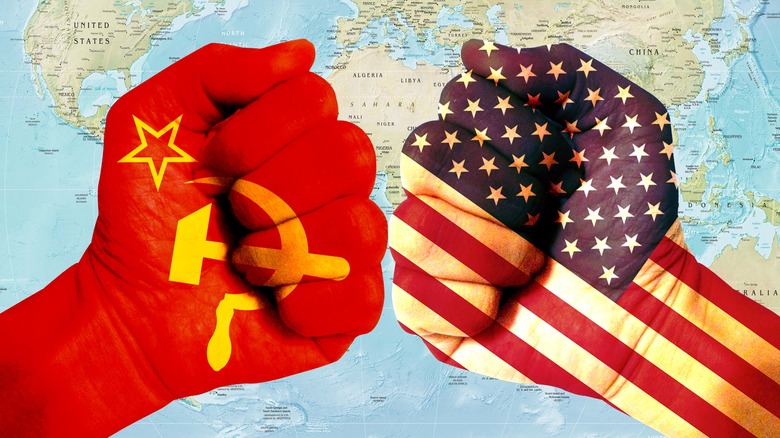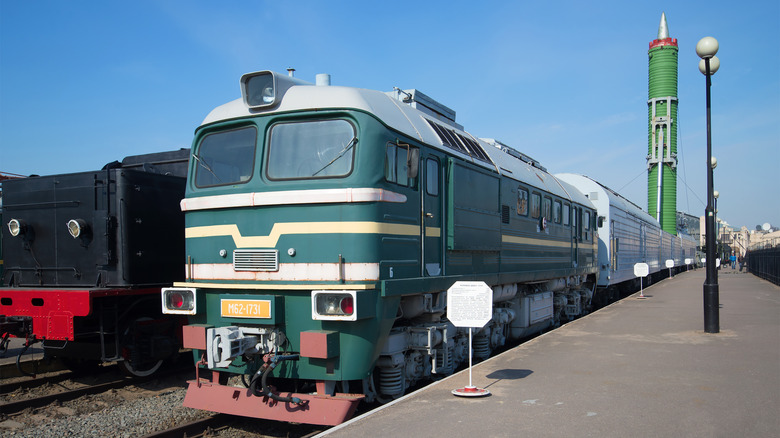Nukes Riding The Rails: The Story Behind The Peacekeeper Rail Garrison
You've likely heard the idiom that what's good for the goose is good for the gander. In this case, what was good for the Soviets was good for the United States, a tit-for-tat stratagem used during the Cold War by both sides. While the only Peacekeeper to come to mind today might be the fictional DC Comics anti-hero played by WWE superstar John Cena, the Peacekeeper Rail Garrison from the 1980s is something else entirely.
English author George Orwell was uncannily prescient about the Cold War when he wrote in 1945, "two or three monstrous super-states, each possessed of a weapon by which millions of people can be wiped out in a few seconds."
The Cold War is generally accepted to have lasted between 1947 and 1991. It wasn't a ground combat war. Instead, the U.S. and its allies waged a different kind of battle using political bullying, economic sanctions, and propaganda against the Soviets, who were hellbent on retaining the Eastern European countries it occupied during WWII under its control while spreading communism far and wide.
In 1948, the Soviets tried to cut off access to certain areas of West Berlin held by the Allies, and things escalated. It was resolved when the West placed an embargo on exports from the Soviet Eastern bloc. Tensions eased slightly in 1953 when Soviet dictator Joseph Stalin died. And while the Cuban Missile Crisis of '62 almost ended in a nuclear confrontation, it proved both sides were unwilling to pull the trigger, and both signed the Nuclear Test-Ban Treaty the following year.
The midnight train to Georgia
Even though the Cuban Missile Crisis was averted, and the Strategic Arms Limitation Talks (SALT) in both 1972 and 1979 were meant to limit the number of nuclear weapons missiles could carry, nothing stopped either side from engaging in a massive proliferation of warheads. Meanwhile, computers, satellites, and ever higher altitude spy planes used during the burgeoning tech explosion of the '80s caused both sides to think outside the box to hide their latest and greatest nuclear toys on, of all things, trains.
The Soviets created the RT-23 Molodets "Ghost Train." Three DM-62 diesel locomotives pulled three launch wagons armed with intercontinental ballistic nuclear missiles (ICBMs). Four other railcars housed command and control, support (loaded with food for 28 days), and a tanker wagon full of fuel and oil. It reportedly traveled 1,000 miles daily and constantly moved to evade detection. Plus, it could easily blend in with commuter or commercial trains as it maneuvered across the country's train network, making it even harder to locate and destroy.
By the mid-80s, then-President Ronald Reagan was concerned the Soviets would find the fixed nuclear missile silos such tempting targets that in 1986, he approved the creation of 100 Peacekeeper Intercontinental Ballistic Missiles (ICBMs). Fifty were to slide into existing silos, while the other half would be installed on trains and become the Peacekeeper Rail Garrison.
All aboard the American nuclear train!
This program consisted of 35 U.S. Air Force trains, with each pulled by a pair of General Motors EMD GP40-2 diesel engines. Two LGM-118 Peacekeeper ICBMs were to be installed on two 87-foot-long launch cars. The LGM-118 Peacekeeper (known also as the MX) missile had a range of almost 6,000 miles. It could carry 10 W-87 nuclear warheads, equal to 20 times the firepower of the atomic bomb dropped on Hiroshima, Japan.
The rest of the train had staffed security cars, a launch control car, one fuel car, and a maintenance car, all of which were armored. Resources onboard allowed personnel to live aboard for month. Each train would be strategically placed at a USAF Air Command base scattered across the country and constantly remain on high alert. Much like the Soviet concept, the idea was to quickly move them around the country's rail network if needed while basically remaining hidden in plain sight.
However, as Cold War tensions again eased, the U.S. government scrapped the entire rail garrison system altogether. Of the 100 Peacekeepers originally ordered, only 50 were made and all were deployed. Beginning in 2002, those remaining were demilitarized as part of the Strategic Arms Reduction Talks.

